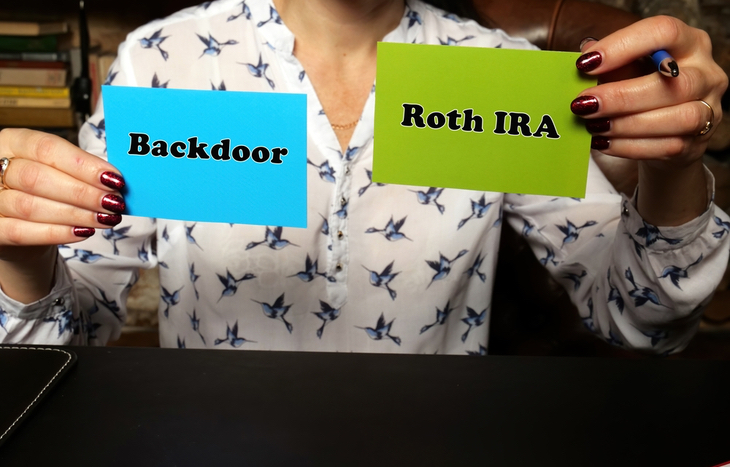What is a Backdoor Roth IRA?
Traditional Individual Retirement Accounts (IRA) are the most prolific types of tax-advantaged accounts out there. They’re designed to make it easier for Americans to save for retirement by themselves. Roth IRAs are even more beneficial, allowing contributions to grow tax-free for decades. Yet, not every American can contribute to a Roth IRA. For these individuals, a backdoor Roth IRA provides a convenient workaround.
Despite the questionable name, a backdoor Roth IRA isn’t illegal, though it is heavily scrutinized. There have actually been attempts to ban the practice in recent years. That said, it remains an open and viable solution to making Roth contributions to an Individual Retirement Account, even if you’re otherwise disqualified from doing so.
Here’s a closer look at backdoor Roth IRAs: how they work, how to take advantage of them and some of the pitfalls and obstacles to setting one up.

The Benefits of a Roth IRA
To understand why anyone would go through the trouble of setting up a backdoor Roth IRA, it’s important to remember the tremendous benefits associated with Roth contributions. No matter how much money you make each year, few investment vehicles compare to the benefits of a Roth account:
- Pre-tax funds grow tax-free for the life of the investment
- Easier to access early withdrawals without incurring penalties
- No required minimum distributions (RMDs) for original account holders
- Inherited funds from a Roth IRA are tax free
Thanks to the power of compounding interest, Roth IRA contributions have exponential potential to grow your wealth over the years. It’s an extremely valuable investing strategy for anyone.
Roth IRA Annual Income Limits
While any individual is free to open and contribute to a Traditional IRA, there are restrictions on who can contribute to a Roth IRA to take advantage of its tax benefits. Specifically, there are income limits set by the IRS. Individuals need to stay below thresholds for their Modified Adjusted Gross Income (MAGI) to make Roth contributions:
- If you’re filing as a single individual, your MAGI must be under $144,000 (2022)
- If you’re married and filing jointly, your MAGI must be under $214,000 (2022)
Earners exceeding these limits can’t make Roth contributions outright. They can, however, explore two strategies for establishing a backdoor Roth IRA.
The Backdoor Roth IRA
A backdoor Roth IRA is effectively a strategy for making traditional IRA contributions, then converting them into Roth contributions. It’s a simple, straightforward strategy that many high-income earners use to capitalize on the benefits of tax-free investment growth. Here’s a look at the two approaches for backdoor Roth IRA creation.
I. The Conversion Strategy
This strategy is the most straightforward. It involves opening a traditional IRA and fully funding it. Then, individuals can convert this traditional IRA to a Roth IRA. It’s important that you don’t claim any deduction on your taxes for the contribution to the traditional IRA, since it will no longer exist when the time comes to file taxes. Only the Roth account will remain, which is subject to tax-free growth.
II. The Two-Step Contribution Strategy
If you need to make incremental contributions, the two-step strategy is best for setting up a backdoor Roth IRA. In this process, an individual makes a non-deductible contribution to their IRA or 401(k) each month, then converts that contribution to Roth. This incremental approach is called “chunking” and helps earners make sure they fall into the right tax bracket based on their income and total deductions for the year.
It’s important to note that both of these strategies involve a hands-on approach to monitoring contributions and making conversions. Many individuals choose to work with an accounting professional who understands backdoor Roth IRAs and the steps involved in creating them.
Beware the IRS Aggregation Rule
If you’re dealing with a mixed IRA, one that includes rollover money and new non-deductible contributions, you’ll need to beware the IRS aggregation rule. Here’s a brief example of what we’re talking about:
If you have $94,000 in a pre-tax rollover IRA and add $6,000 in non-deductible contributions, you’ll have $100,000 total, in aggregate. If you convert that $6,000 to a Roth contribution, the IRS will treat it as though you just converted 6% of your total pre-tax IRA funds. The result? A massive tax bill!
To avoid triggering an unfair tax bill, make sure you move all funds over to your current IRA before making a backdoor contribution. This will nullify the IRA aggregation rule and protect all future backdoor contributions from triggering a taxable event.
Beware the Step-Transaction Doctrine
It’s important to also consider the Step-Transaction Doctrine, which might lump contribution and conversion into a single step. If you’re barred from making Roth contributions outright due to income levels, Step-Transaction Doctrine will trigger a tax bill and IRS scrutiny. Therefore, many financial advisors recommend waiting between one and six months between the initial contribution and the Roth conversion.
Backdoors are Legal, Yet Scrutinized
As mentioned, backdoor Roth IRAs are legal, and they’re a great way for high-income individuals to reap the same tax-advantaged benefits as lower-income earners. However, they fall into a grey area of personal finance: a loophole. As a result, it’s important to make sure you’re following each step of the backdoor process within the framework of IRS established guidelines. Forgetting to convert a contribution or exceeding contribution limits could trigger massive tax penalties.
It’s best to work with a personal finance expert when setting up a backdoor Roth IRA, namely someone who has experience with high-net-worth individuals or high-income strategies.





